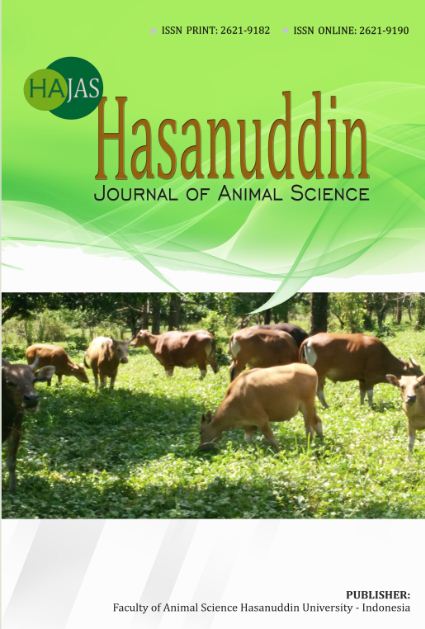Rumen Fermentation of Local Grasses Feed to Native Goat
Abstract
The aim of this research was to examine the feed rumen fermentation in the rumen of goat fed 4 different diets. This study was designed based on the Latin Square Design which consists of 4 diet treatments with 4 replications in each diet treatment. A total of 4 male goats, with relatively the same weight and age, were randomly assigned to an individual metabolic cage fed with 4 diets. The four diets studied were R1: Elephant grass, R2: Mini elephant grass, R3: Panicum maximum grass and R4: Brachiaria decumbens grass. Each diet was added with 20% of rice bran. The result of this experiment indicated that there was no any significant effect of different diets on the pH values, concentrations of VFA (Volatile fatty acids), and Ammonia (NH3) in the rumen of goat. The pH values in the rumen of goat treated with R1, R2, R3, and R4 were 7.17, 7.12, 7.07, and 7.0, respectively. The concentration of ammonia (mM) in the rumen of goat treated with R1, R2, R3, and R4 were 4.6, 3.3. 4.5, and 4.1, respectively. Whereas the level of VFA (mM) in the rumen of goat treated with R1, R2, R3, and R4 were 40.4, 43.6, 48.7, and 49.9, respectively. There was no any significantly difference (p>0.05) in the characteristic of rumen fermentation between the diet treatment. This might be due to the similarity in the nutrient content of those grasses studied. The characteristic of rumen fermentation was in the range of optimal growth of rumen microbes. It is concluded that those of four grasses studied edible, acceptable and contain a good nutrient as a feed resource for goat. The nutrient content of the grasses studied creates a good rumen environment for optimum feed fermentation in the rumen of goat.
Downloads
Published
Issue
Section
License

This work is licensed under a Creative Commons Attribution-NonCommercial 4.0 International License.











